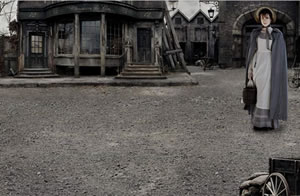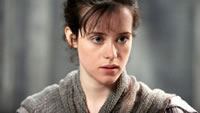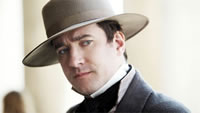A Very Victorian Tale of The Credit Crunch
We meet Little Dorrit's Art Director Paul Ghirardani
|
It’s a timeless rags to riches story concerning the vacillating fortunes of the Dorrit family. The kind-hearted Amy (Claire Foy), the Little Dorrit of the title, looks after her proud father, William (Tom Courtenay) who is a long-term inmate of Marshalsea debtors' prison in London.
But their fate is transformed by the unexpected arrival from overseas of the benevolent Arthur Clennam (Matthew Macfadyen), who is determined to solve the mystery of his father's dying words, "Put it right, Arthur." He is sure this phrase is in some way connected to the Dorrits' plight and sets about rectifying the situation - discovering they are sitting on a huge fortune, a fact which thrusts the family into the upper echelons of society....
That's a quick synopsis of the storyline, but it was the creative talents of Art Director Paul Ghirardani that gave life to the evocative interiors, exteriors and buildings such as the iconic Clennam house that were so admired during the the popular BBC adaptation of Dickens' novel and discussed in great detail on the forum.
“I was approached in January by the producer with 16 scripts, one is bad enough but having to wade through 16 is phenomenal! So I had to try and formulate in my head a plan about how we were going to set about it," explained Chiswick resident Paul.
“We began with build the exterior of Clennam house at Pinewood Studios but you can’t just build a house in isolation, we had to build streets and the square around it. We also built a series of alleyways one of which led to the gates of Marshalsea Prison. We then took those gates with us when we were filming at Hampton Court, they were the connector. Connectors are always a problem, you have to really go for them or else it doesn’t work. For example all the brickwork at Pinewood was copied in great detail to make sure it was a perfect match to the brick work at Hampton Court.
 “We had to build the Clennam house with the end in mind knowing that in six months time we would be destroying it on camera. So we built in weak spots around the windows and doors so we could collapse it quickly. You have to plan quite far ahead.”
“We had to build the Clennam house with the end in mind knowing that in six months time we would be destroying it on camera. So we built in weak spots around the windows and doors so we could collapse it quickly. You have to plan quite far ahead.”
The house became Paul’s favourite part of the production “Those sets at Pinewood were quite a special build. We like to build things in straight lines but the Clennam house wasn’t build that way, we had to make it crooked. The house was such a character in itself; you wouldn’t find that on location. We built the interior on a stage at Pinewood with the two storeys side by side and a staircase for Flintwhich and his Mrs to go up and down with their candle.
“Dicken’s stories are very much character led and that house took on a life of its own. The great joy of his [Dickens] work is in character and detail, he wrote ‘filmily’ for Victorian times.”
Little Dorrit has been described as a Victorian tale of the credit crunch. Did Paul agree with this? “Meagles is very high end Dickens; he had never done such rich characters before. For his death I had in mind a painting – The Death of Marat – so that scene was based on that painting. We called the Meagles the Abromavichs of their time. I suppose there are similarities between Meagles and Madoff, he lost his money by moving it around. Although the credit crunch hadn’t really hit when we began this project so it certainly wasn’t planned that way.”
Paul studied Interior Design at Kingston Art College “But it wasn’t my thing so I moved into theatre and worked there for eight years on shows like Starlight Express, and Les Miserables before moving into opera. Then eventually I met someone who worked in film and never looked back. Better money and just fun so I’ve done it ever since.”
His first film was Crying Game “Forrest Whitaker was amazing and the transvestite was a hairdresser who was given a flyer in a club and just turned up on set!”
“Now I do mainly period drama, I know it well and know all the pitfalls; I can do it. I’ve never done science fiction, I’m happy with the Victorians and Georgians and they’re better stories quite frankly. Without a good story to hang your clothes on, you’ve got nothing.”
Paul met his partner Jan whilst watching a ballet at the Royal Opera House. They began house hunting in Ealing before an estate agent there asked them if they’d tried Chiswick. “’It’s like being on holiday,’ she told us so we came to have a look and absolutely loved it.”
The couple now live ‘very happily’ in Devonshire Road. “We got to know everyone in such a short space of time. There’s a huge sense of community in Chiswick which Devonshire Road has got in spades.” I particularly like the way he refers to the owner of Top Hat Dry Cleaners as ‘Mike Moran Business Man’ I think it rather suits him!
Does his bring his design work home with him? “When I’m doing Dickens I decide we’re going all Victorian, with Medieval I see beams everywhere!” he laughs. “The thing is I invest so much energy into my projects that I’ve never really formulated design for myself. I do envy people who have these eclectic homes but with me it would be such a mad mixture of whatever I’m doing at the time, I’d be living in Mrs Clennam’s home right now!”
Paul is currently working at the BBC on a production called Desperate Romantics based on a book by Fran Moyles. “The BBC is sexing up the pre-Raphaelites, it’s a little bit irreverential. It should be on a screen near you in June.”
For those who missed any episodes of Little Dorrit, some are available on BBC IPlayer or the box set will be released in January.
December 21, 2008

